
Battle of Fort Riviere (source)
Woodrow Wilson took office pledging to curtail the gunboat diplomacy of his Republican predecessors. Yet he inherited conflicts in Cuba and Nicaragua, experienced tensions with revolutionary Mexico and chaos in Haiti. To justify intervenions, Wilson struck a typically moralistic tone, pledging "I am going to teach the South American republics to elect good men!"In reality, Wilson's interventions evinced a queer admixture of motives. There was a sincere, if paternalistic conviction that America should educate its neighbors in good government. Also fear of European nations, especially Germany, expanding their influence in the region. More crass economic and business concerns often entered into the equation, along with national pride and racism. America's decades-long presence in Haiti combined all of the above, with a helping of cruelty.
Since Toussaint L'Ouverture's slave rebellion against France, the United States entertained a diffident, often hostile relationship with Haiti. Presidents from Jefferson through Buchanan refused to recognize the "black republic," fearful of inspiring slave revolts at home; only in 1862 did Abraham Lincoln extend recognition. Even then, Haiti remained a chronically poor nation, suffering from uneven trade with foreign powers, limited economic development, class divisions between the mulatto elite (mostly French-speaking Catholics) and poor blacks (who spoke Creole and practiced Voduon), and endless political turmoil.
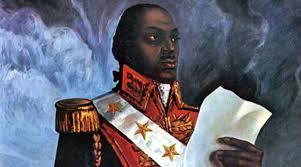
Touissant L'Ouverture
American sailors and Marines had, in fact, intervened in Haiti nineteen times between 1859 and 1913. Yet events seemed especially urgent in 1915; the Haitian economy collapsed due to defaulted loans, while President Vilbrun Giullaume Sam's repressive regime triggered a rebellion within months of his taking office. Secretary of State William Jennings Bryan was alarmed by increased German investments in the country and encouraged by Roger Farnham, vice president of National City Bank, to receive Haiti's debt. "There is probably sufficient ground for intervention," Bryan wrote Wilson, "but I do not like the idea of forcibly interfering on purely business grounds."Fortunately, President Sam obliged them. In July 1917 he ordered the massacre of 167 political opponents in Port-au-Prince, leading to a massive popular uprising. Sam fled to the French embassy, where a mob cornered him on July 28th and hacked the hapless president to death. His body parts were paraded through the streets, his head and limbs mounted on fence posts. Informed of the gruesome spectacle, Wilson concluded "there is nothing for it but to take the bull by the horns and restore order."
That same day, 330 American Marines landed in Port-au-Prince. They marched in textbook order through the streets, facing little resistance. The Haitian army melted away, leaving only a handful of snipers and hostile citizens to oppose them. One Marine column was pelted with garbage by angry civilians; another group of leathernecks endured human excrement dumped on them from a window. Yet there were only two American casualties, caused by friendly fire between Marines and sailors.
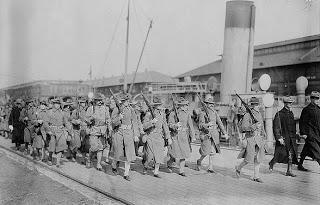
Marines arrive in Port-au-Prince
As reinforcements secured the city (eventually numbering 3,000 men), Admiral William Caperton arrived to reestablish order. He considered appointing Sam's rival, Rosalvo Balbo, president, but considered the man unstable and unreliable. Another prominent Haitian, J.N. Leger, refused appointment, telling Caperton that "I am for Haiti, not the United States." Eventually Philippe Sudre Dartiguenave, President of the Senate, assumed the post; on August 12th, the Haitian legislature ratified his presidency in an assembly packed with armed Marines.There was markedly little pretense of freedom. Dartiguenave was a natural-born collaborator; one American approvingly commented that "He has repeatedly and publicly made known his intention...to do everything the US wishes." His only initiatives involved cracking down on the press, complaining that "liberty is being smothered under licentiousness." Meanwhile, President Wilson sent Addison T. Ruan as a "financial adviser" to consolidate Haiti's national bank, naval pursers took over Haitian customs houses, and Admiral Caperton declared martial law in September 1915.
One story claims that President Dartiguenave (so disliked that he went everywhere with Marine bodyguards) balked at signing an American-drafted treaty. Major Smedley Butler, America's most decorated and feared Marine, arrived at the National Palace with the treaty in hand. He found Dartiguenave sitting on a toilet reading a newspaper, then forced the humiliated President to sign. Possibly apocryphal, this colorful tale endures because it graphically demonstrates Haiti's submission to America.
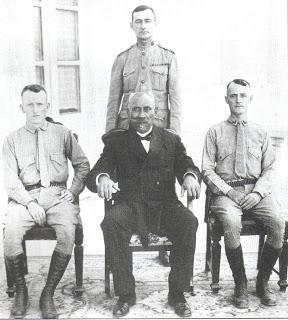
President Dartiguenave (seated) with Marines
Not everyone submitted, of course. Guerrilla bands known as cacos formed in the countryside, terrorizing Marines by blowing on conch shells and laying haphazard ambushes. In November, Major Butler led a small Marine patrol to the mountain stronghold at Fort Riviere. Butler, who won a Medal of Honor for this action, marveled at their awful marksmanship: "We were fighting people who did not know what sights were for... they threw away their rifles and reached for rocks." Rocks proved no match for machine guns; Butler's force killed 51 Haitian rebels, with one Marine losing two teeth.Yet most resistance was passive, consisting of angry glares and refusal to collaborate. Marine Sergeant Faustin Wirkus recalled that the Marines "marched over the cobble-stoned streets of the waterfront through walls of human silence and dead-eyed stares." As Butler organized a Haitian gendarmerie, educated mulattos refused his invitation to become officers. Even the Haitian press wouldn't buckle, with one editor vowing that President Wilson would "on his death bed eat les excrements de son vase."
Admiral Caperton at least made shows of conciliation: he and his aide, Captain Beach, charmed and entertained Haiti's educated mulattoes while restraining his subordinates from unnecessary violence (one Marine complained that Caperton "knifes [his men] when they do well"). Not so Littleton Waller, the Marine Colonel who arrived in October 1915. Waller was already notorious for his conduct in the Philippines; in 1902 he had been tried for executing eleven porters suspected of mutiny, only for President Roosevelt to dismiss the charges. His arrival ensured increased brutality.
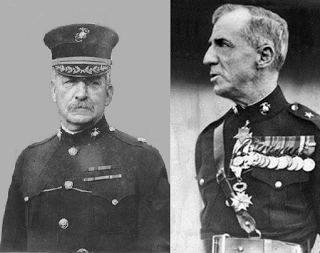
Marines enforcing Empire: Littleton Waller (left) and Smedley Butler
For Waller, a Virginian, evinced the ugliest racial attitudes of his time. He wrote that "there is not an honest man in Haiti" and "there are some very fine, well-educated polished men here but they are real nigs beneath the surface." He detested socializing with mulattoes, referring to it as "bowing and scraping to coons," and promoted follow southerners to key posts, feeling they were better equipped to "handle" blacks. When President Dartiguenave criticized Waller's behavior, the Colonel threatened to withdraw Marines from Port-au-Prince and leave the President at the mercy of his enemies.It wasn't only southerners who treated the Haitians with contempt. Marines and sailors echoed Waller's language, labeling Haitians "spigs," "niggers" and "gooks." Incidents of violence, rape and casual murder became distressingly frequent: Haitian child Joseph Danticat witnessed several Marines kicking a native's severed head around like a soccer ball. Even Smedley Butler, a Pennsylvania Quaker, referred to Haitians as "bad niggers," "shaved apes" and "miserable cockroaches," and his gendarmes as "chocolate soldiers."
When Franklin Roosevelt, Assistant Secretary of the Navy, visited Port-au-Prnce in January 1917, awkwardness and insult compounded. During a reception at President Dartiguenave's palace, white American women humiliated black Haitian men by refusing to dance. Roosevelt's aide remarked that one of Dartiguenave's ministers "would have brought $1,500 at auction in New Orleans in 1860 for stud purposes." The crowning humiliation came when Roosevelt and Dartiguenave left the reception; when the President attempted to enter a waiting car first, the ubiquitous Major Butler grabbed his collar and pulled him back onto the curb.
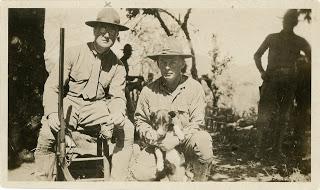
FDR in Haiti (source)
Such humiliations belied any pretense of progress. American administrators, adopting ideas from the Jim Crow South, liquidated Haiti's liberal arts colleges and medical schools for vocational training, believing blacks and mulattoes unsuited for higher education. Others attempted to consolidate small farms into massive plantations, earning peasant enmity and resistance. Haitians labored for twenty cents a day, forced to humor their overseers' futile attempts to introduce bananas, cotton, pineapple and even rubber trees onto Haiti's infertile soil (sugar and coffee proved more successful). This led thousands of Haitians to flee for Cuba and the Dominican Republic.Yet this was nothing compared to the brutal corvee system. Tasked to improve Haitian infrastructure, Major Butler brushed off an arcane Haitian law permitting him to conscript thousands of Haitians (some criminals, most innocent peasants) in unpaid slave labor. Chained together in huge groups, prodded, abused and occasionally killed by Butler's gendarmes, they constructed a 170 mile highway between Port-au-Prince and Gonaives. Butler crowed about his achievement while assuring his superiors, "It would not do to ask too many questions about how we accomplish this work."
Before departing for France in 1917, Smedley Butler placed one last stamp on Haiti. When Haiti's legislature refused, first to approve an American constitution and then to declare war on Germany, Butler emerged to bring them into line. Gaining signatures from President Dartiguenave and his cabinet, Butler marched to the assembly on June 19th with several gendarmes and ordered the legislature dissolved. When legislators booed and threatened Butler, his men aimed loaded rifles at them until they acquiesced. Thus did Woodrow Wilson's men make Haiti safe for democracy.
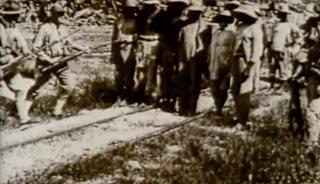
Corvees at gunpoint (source)
The following June, Haitians approved the American-backed constitution via plebiscite, by a margin of 98,225 to 768. This gave American officials and businesses massive influence in Haiti, though the country's turmoils made major investors wary of taking advantage. World War I allowed for the liquidation of foreign interests; 210 German nationals were interned by the Haitian government, their property seized by the state and shares in government works turned over the United States.1919 saw a fresh outbreak of violence. It centered around Charlemagne Peralte, a mulatto trained as a lawyer, who was imprisoned for anti-American activity. Escaping a work detail in Cap Haitien, Peralte fled into Haiti's northern mountains, organizing a band of 5,000 cacos. Vowing to "drive the invaders into the sea and free Haiti," Peralte led a nationwide rising that far outpaced the previous violence. From April 1919 on, there were guerrilla attacks and full-scale raids across the country, along with an abortive attack on Port-au-Prince itself.
With the gendarmes nearly useless (their officers discouraged target practice for fear that they'd turn their guns on the Americans), the Marines re-arrived in force, brutally putting down the rebellion. Using machine guns and airplanes, the Americans slowly decimated the attackers, inflicting thousands of casualties. Peralte himself was assassinated by two Marines in blackface who infiltrated his camp. His body was staked in an open door and left to rot; intended to intimidate Haitians, instead it inspired them to renewed resistance.
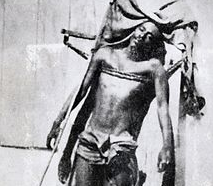
Haitian pieta: Charlemagne Peralte in death
Even so, the Marines' brutal tactics (described frankly by Colonel John Russell, Waller's successor, as "practically indiscriminate killing of natives") wore down resistance through sheer savagery. Peralte's successor, Benoit Batraville, led another desperate assault on Port-au-Prince in January 1920 which resulted in hundreds of casualties. This effectively broke the resistance: at least 3,000 Haitians were killed, with some estimates approaching 12,000, in the Second Caco War.Now Americans were reconsidering their policies. The NAACP and other liberal groups advocated for the withdraw of American forces from Haiti, exposing atrocities and brutality ("Don't Make Haiti America's Congo" became an anti-imperialist slogan). Warren G. Harding made the occupation a campaign issue in 1920, demanding an investigation into military abuses. Woodrow Wilson, for his part, remained unrepentant. Upon leaving office, he wrote that "I have been part of this record from the first, and there is nothing in it to be ashamed of at any point."
Despite his rhetoric, Harding did little to change policy. In 1921, a Senate panel convened to investigate American conduct in Haiti. Despite lurid testimony about colonial abuses, the Senators reaffirmed the occupation. Its chairman, Medill McCormick, opined that "in my judgment we ought to stay there for 20 years." Nonetheless, through the '20s American rule became more benign, with John H. Russell instituting reforms and infrastructural improvements. President Dartiguenave, despised by Haitians and distrusted by Americans, left office in 1922; he was replaced by Louis Borno.
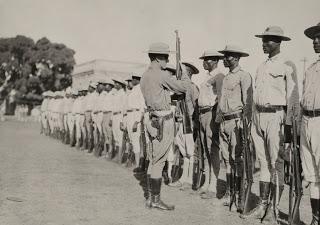
Gendarmes with American instructor
Yet Haiti erupted again in 1929, triggered by the Great Depression and postponement of an election. Widespread protests and strikes spread throughout the country, culminating in the Les Cayes massacre that December. Marines armed with rifles and machine guns shot 24 protesters, triggering fresh outrages and demands for American withdrawal. In November 1930, new elections placed nationalist Stenio Vincent in the presidency, showing that Haitians would no longer tolerate American control.It wasn't until 1934, however, that withdrawal occurred. Now-President Franklin Roosevelt discouraged Latin American meddling in his Good Neighbor Policy, and on August 15th, 1934 the last Marines left Haiti. Haitian elites responded with a new nationalism, rejecting their French affectations for African nationalism, but the country remained mired in poverty and subject to coups and dictatorships - with the National Guard, descendants of Smedley Butler's gendarmerie, remaining a powerful force in its government.
Smedley Butler later repented of his imperial past, denouncing himself as a "racketeer for capitalism" and advocating for pacifist causes. It's easy to criticize Butler's actions on Haiti and elsewhere, yet he and his colleagues were merely instruments of a confused policy that promised freedom, condoned brutality and ensured exploitation. Even the most idealistic President and the most honest Marine couldn't avoid that outcome.
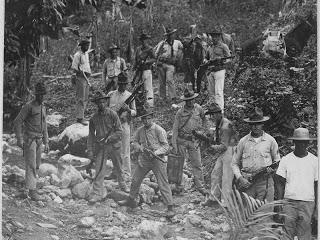
Source
Sources and Further Reading:This article draws upon: Max Boot, The Savage Wars of Peace: Small Wars and the Rise of American Power (2002); Lester D. Langley, Banana Wars: An Inner History of the American Empire, 1900-1934 (1983); Mary A. Renda, Taking Haiti: Military Occupation and the Culture of US Imperialism (2001); and two works by Hans Schmidt, The United States Occupation of Haiti, 1915-1934 (1971) and Maverick Marine: Smedley D. Butler and the Contradictions of American Military History (1998).
Other articles on the Age of Wilson:
- The American Polar Bears Meet the Bolsheviks
- The American Protective League and the War on Slackers, 1917-1919
- Appointment at Veracruz, 1914
- General Graves and the Siberian Shuffle
- The Hun's Shadow in America, 1917-1918
- Racism, Riot and Mutiny in Houston, 1917
- Somerset County's Men of Iron in the Great War

